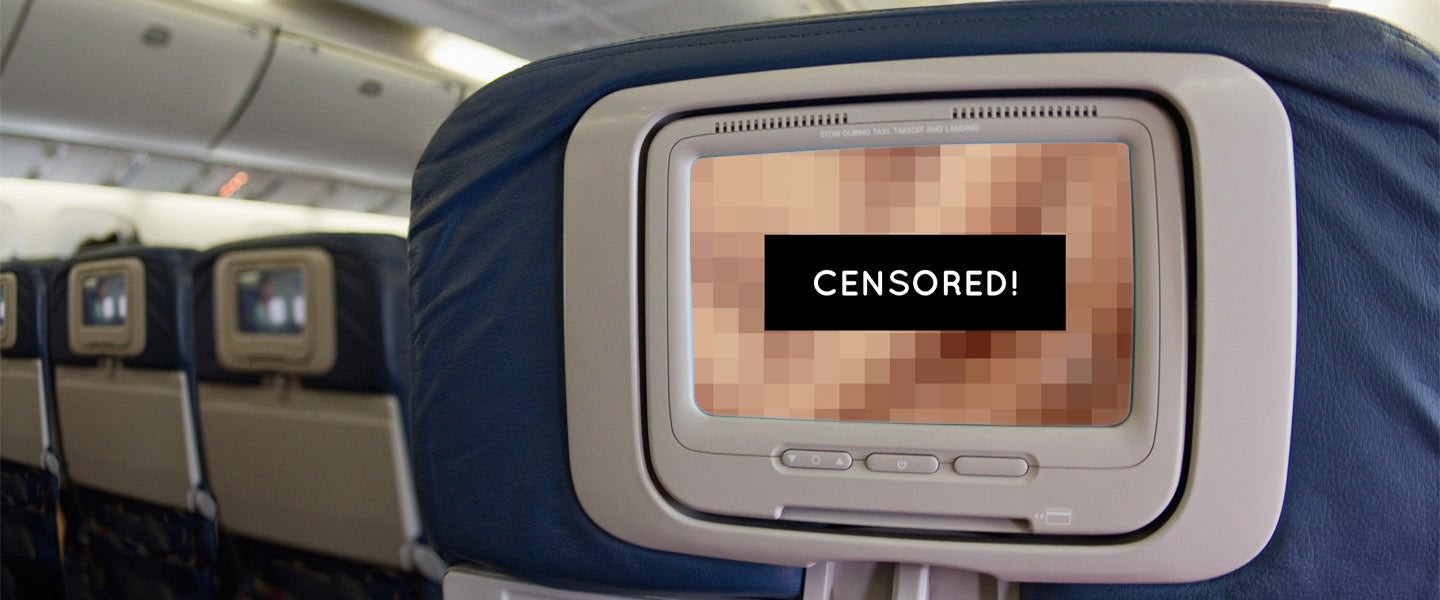In 1961, By Love Possessed became the first in-flight movie to ever be shown on a flight, by Trans World Airlines. “The screening was in the first-class cabin only and was the result of a eureka! moment for the technology’s mastermind, David Flexer,” reports Wired. Thankfully, nowadays, in-flight entertainment — whether it comes via an iPad or the screen monitor built into the airplane seat is available to everyone and is as much a part of the in-flight experience as not having enough leg room.
But of course, deciding what to watch aboard a plane, amongst strangers or even worse, the children of strangers, can be a bit of a headache. It may be true that you love watching steamy French thrillers while soaring at 30,000 feet, but it’s probably also true that you’d rather not be the guy to introduce the tiny human seated next to you to a vigorous, wobbly love scene.
Before you start sweating through that uncomfortable reality, though, it may surprise you to find out that there is quite a bit of data that goes into compiling your in-flight programming (which is why flight attendants will rarely bat an eye if it’s on your seat-screen — it’s all airline approved already). “In their research, Global Eagle [an in-flight entertainment content service provider that supplies digital content to 185 airlines worldwide] takes a look at genre, time of year and previous best performers,” reports Thrillist. “For instance, children’s programming sees a spike in the summer due to school breaks and family vacations, so they’ll package family-friendly programming for airlines during that time. Travelers heading to cultural hotspots like Italy or France tend to have more interest in ‘artistic’ movies, [Walé] Adepoju [the executive vice president of content and media at Global Eagle] says.” Basically, even your in-flight entertainment options aren’t free from the insights of big data.
Interestingly though, your in-flight entertainment is, in many cases, also censored. According to a report in InsideHook, while movies are sometimes edited to leave out the parts that may scare passengers — e.g., scenes with turbulence or plane crashes — the edits can also be fairly arbitrary. Last month, Olivia Wilde called out Delta for editing out the same-sex love scenes in her movie Booksmart. “The Booksmart controversy comes just days after the airline was called out for showing an edited version of the Elton John biopic Rocketman that was ‘stripped of almost every gay reference or scene … including a simple chaste kiss,’” reports InsideHook.
To that end, in the same article, InsideHook noted that the vice-president of corporate communications of Global Eagle was quoted as saying, “We dub and edit movies for global audiences, including children on board, and at the same time we are required to obey local laws and local religious sensitivities. That includes for sensitivities across Europe, the Americas, Asia, Middle East and Africa. Each airline has its own requests and we respect our customers’ wishes.” Which sounds like a cop-out, but what else did you expect from the VP of corporate communications?
But let’s say that despite all this, you’ve still found yourself watching a movie that’s wildly inappropriate for the irritatingly curious four-year-old next to you. What to do? A reverse of this predicament occurred to a couple aboard a Delta flight to California. “My wife was in the middle with my daughter on the window,” writes Dan Miller on Points with a Crew, a blog intended to help families fly cheap. “They were watching their various movies when my wife noticed the movie the woman diagonally in front of her (on the aisle of the row in front of her) was watching. She first noticed a fairly graphic sex scene that turned into some pretty graphic violence. Later there was another sex scene with (blurred) nudity.”
The responses to Miller’s post are a mixed bag, ranging from, “if you don’t like what you see, just look away,” to “the airplane is a public place and therefore people should use common courtesy when watching certain movies on flights.” “It appears that the standard now is if I paid for it, I have a right to do whatever I want, and I don’t care about others,” writes one person.
Despite the regular censorship of in-flight entertainment, ironically there are no FAA rules that dictate what a person can or cannot watch on their own devices: In one 2014 case, a passenger watched porn on a flight, and although Delta released a statement that warned against porn-watching while flying, they didn’t do much else. Instead, the expectation is simply that the average person will use their best judgement, which, lol.
In theory, then, you should save that steamy, uncensored French thriller on your tablet for a more private viewing experience. Or, per one redditor responding to a similar thread on whether it’s okay to watch Game of Thrones on a flight, it means taking a few extra precautions to make sure you’re not offending your fellow passengers. “If you insist on watching Game of Thrones on a plane at least put a sweatshirt in the cracks between the seats and angle the screen so that no one else has to watch it,” he writes.
Because, come on man, not everyone is into incest.

